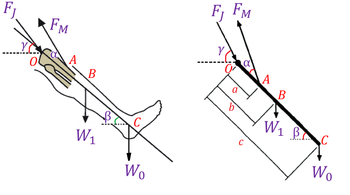
Concept explainers
The figure shows a person wearing weight boots and doing lower leg flexion/extension exercise in a sitting position to strengthen the quadriceps muscles and a simple
Find the component (FJx) of the joint reaction force in the x direction. (Write your result in size N.)
a.
246,064
b.
184.55
c.
162.40
D.
282.97
e.
128.20

Step by stepSolved in 4 steps with 3 images

- Hi second question please. This an engineering statics problem.arrow_forwardThe figure shows the forearm of a person holding a book. The biceps exert a force FB→, and the book has a mass of 3.1 kg. Calculate the magnitude of the force in the elbow joint in units of newtons.arrow_forwardHi engineering statics questionarrow_forward
- A metal rod of length L=8.88 has only three forces applied to it in the directions shown in the diagram below. Force #2 is applied at the midpoint of the rod. If the rod is in static equilibrium and the magnitude of force #1 is 7.15, what is the magnitude of force #2?arrow_forwardQ2/ In the nucleus pulposus of an intervertebral disc, the compressive load is 1.5 times the externally applied load. In the annulus fibrosus, the compressive force is 0.5 times the external load. What are the compressive loads on the nucleus pulposus and annulus fibrosus of the L5-S1 intervertebral disc of a 90 kg man holding a 50 kg weight bar across his shoulders, given that 63% of body weight is distributed below the disc?arrow_forwardPlease provide the diagnosis, free body diagram, reaction forces and internal forces for the following figure:arrow_forward
- Please solve review question . I am also confused in the second part of the question by what it means to express loads by the approximation % of the body weight.arrow_forward7. The arrangement in the drawing shows a block (mass = 14.0 kg) that is held in position on a frictionless incline by a cord (length = 0.582 m). The mass per unit length of the cord is 1.30 x 10-2 kg/m, so the mass of the cord is negligible compared to the mass of the block. The cord is being vibrated at a frequency of 166 Hz (vibration source not shown in the drawing). What is the smallest angle 0 between 15.0° and 90.0° at which a standing wave exists on the cord?arrow_forwardHer foot pivots as a single structure about a single pivot in her ankle. When she stands on tiptoe, her foot pivots about her ankle. As shown in the foot diagram and the free-body diagram below, the forces on one foot are an upward force on her toes from the floor, a downward force on her ankle from the lower leg bone (called the Tibia), and an upward force on the heel of her foot from her Achilles Tendon. Suppose a 61.3 kg woman stands on one foot, on tiptoe, with the sole of her foot making a 25.0 degree angle with the floor, and with the distances are as shown in the figure.arrow_forward
- An automatic door lock system is to be designed for automatically locking/unlocking car doors. The design will utilize an electric solenoid with sufficient force and stroke to provide the necessary motion. If the force required to drive the lock linkage is 9.5 N, determine if the solenoid with the following specifications meets this requirement: Number of turns Current Air gap Plunger dia, 2500 1.0 Amps 10 mm 18 mm The initial force available from a solenoid F P=2(ND)² HA 82arrow_forwardDear, Can you please give me the solution to this question and provide it with side drawings and explanations to understand the solution better? Thank you in advance!!arrow_forwardNeeds Complete typed solution with complete explanation and 100 % accuracy.arrow_forward
 Elements Of ElectromagneticsMechanical EngineeringISBN:9780190698614Author:Sadiku, Matthew N. O.Publisher:Oxford University Press
Elements Of ElectromagneticsMechanical EngineeringISBN:9780190698614Author:Sadiku, Matthew N. O.Publisher:Oxford University Press Mechanics of Materials (10th Edition)Mechanical EngineeringISBN:9780134319650Author:Russell C. HibbelerPublisher:PEARSON
Mechanics of Materials (10th Edition)Mechanical EngineeringISBN:9780134319650Author:Russell C. HibbelerPublisher:PEARSON Thermodynamics: An Engineering ApproachMechanical EngineeringISBN:9781259822674Author:Yunus A. Cengel Dr., Michael A. BolesPublisher:McGraw-Hill Education
Thermodynamics: An Engineering ApproachMechanical EngineeringISBN:9781259822674Author:Yunus A. Cengel Dr., Michael A. BolesPublisher:McGraw-Hill Education Control Systems EngineeringMechanical EngineeringISBN:9781118170519Author:Norman S. NisePublisher:WILEY
Control Systems EngineeringMechanical EngineeringISBN:9781118170519Author:Norman S. NisePublisher:WILEY Mechanics of Materials (MindTap Course List)Mechanical EngineeringISBN:9781337093347Author:Barry J. Goodno, James M. GerePublisher:Cengage Learning
Mechanics of Materials (MindTap Course List)Mechanical EngineeringISBN:9781337093347Author:Barry J. Goodno, James M. GerePublisher:Cengage Learning Engineering Mechanics: StaticsMechanical EngineeringISBN:9781118807330Author:James L. Meriam, L. G. Kraige, J. N. BoltonPublisher:WILEY
Engineering Mechanics: StaticsMechanical EngineeringISBN:9781118807330Author:James L. Meriam, L. G. Kraige, J. N. BoltonPublisher:WILEY





